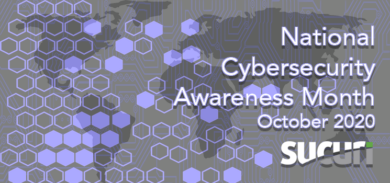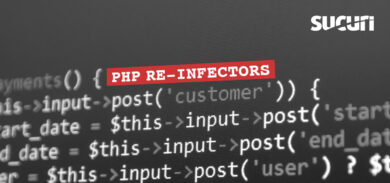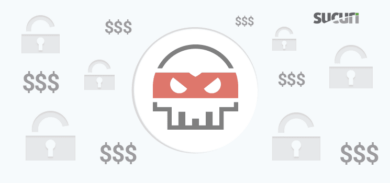October is National Cyber Security Awareness Month, and we’re back with analyst Antony Garand to take a deeper look into cross site scripting (XSS) attacks and WordPress plugin vulnerabilities. Plus, host Justin Channell will catch you up on the latest website security news from the Sucuri blog.
For further reading about any of these topics, check out these blogs we reference in the episode:
- WordPress Malware Disables Security Plugins to Avoid Detection
- Critical Vulnerability in File Manager Plugin Affecting 700k WordPress Websites
- Reflected XSS in WordPress Plugin Admin Pages
- Backdoor Shell Dropper Deploys CMS-Specific Malware
- Magento Multiversion (1.x/2.x) Backdoor
Justin Channell:
Hello and welcome to the Sucuri Sit-Down. I’m your host Justin Channell, and this is a monthly podcast about website security, where we get in depth with the malware removal experts here at Sucuri. Later in the show, I’ll sit down with our analyst, Antony Garand, to talk about cross-site scripting and WordPress plugin vulnerabilities.
Justin Channell:
Now it’s been a few months since our last episode, but that’s because we’ve been keeping busy behind the scenes preparing for National Cybersecurity Awareness Month. If you’re not already following us on social media, October 2020 is the best time to start. We have a ton of content coming out and a lot of great stuff planned, including a contest that’s exclusive to our Twitter community. So follow us at Sucuri Security. But as always, we’re also keeping up with publishing the latest attacks and vulnerabilities on our blog. Before we get started with Antony, let’s take a deep dive into a few of the topics we’ve covered on the blogs since episode three. If you want to get a more in-depth look at any of these topics, check out the show notes for a link to the full blog.
Justin Channell:
Luke Leal, who we spoke with in episode three, wrote about an interesting example of WordPress malware back in September. Most WordPress users are probably aware that there are a lot of security plugins available, including Sucuri’s own free plugin. Now these plugins are a helpful tool for identifying WordPress attacks, but they won’t do much good if an attacker can disable them, and that’s exactly what Luke found with this malware. It would disable all of the most popular security plugins. If you would re-enable them, they would quickly be disabled again. The reason why it was so efficient at disabling was because the code was written into the wp-load.php file on the website. That file’s going to load every time there’s a page load on a WordPress environment. So let’s say your site was infected and you re enabled all the plug-ins. As soon as you check the live site, the plugins are going to be disabled. Even if another user loads a page on your site, it’s going to trigger the malware to disable those plugins again. So if you have a really popular site, it may be impossible to keep them disabled for only a couple of seconds. And malware like this makes it clear why a plugin, alone, isn’t going to be enough to protect your website. You’re going to need a solution that scans the website at the server level to get the best protection.
Justin Channell:
Also, the reinfection of this shows why it’s so important to completely clean a website hack. Bad actors are going to want to retain access to the compromised environment as long as possible, and they’re going to use every tool at their disposal to do so, whether that means using a backdoor or an automated reinfection technique like this example. Think of it like taking antibiotics for an infection. If you don’t finish the round of antibiotics, the infection won’t be completely gone and it can potentially get worse. Also, we recently found malware that could add an arbitrary user inside of WordPress and then elevate that user to an administrator status. Krasimir Konov wrote about this back in late August. A bit of code was hidden inside of a plugin’s functions.php file. And that would add the user and then elevate its status. By elevating the status to an administrator, that would give an attacker complete access to the WordPress environment. And again, this is another example of an attack that a server-side scanner can mitigate better than a plugin.
Justin Channell:
We’ll be talking about WordPress plugin vulnerabilities later though. In the meantime, let’s catch up with what’s going on with Magento e-commerce stores. We’re well past the Magento one end of life date, but there are still a lot of e-commerce sites using it and struggling to migrate to the new version. Hackers are well aware of this and they’re actually making tools that will target all versions of Magento. Tools like this will make website attacks more successful and profitable for bad actors. That’s why you really need to consider upgrading your Magento 1 sites to Magento 2 at this point. However, if for whatever reason you can’t do it, get ahold of us because our website security platform actually does have virtual patching, which can protect you from a lot of vulnerabilities.
Justin Channell:
But just keep in mind, while you may hear about Magento or WordPress vulnerabilities or attacks, every CMS can be a target. In fact, October has already brought an interesting malware dropper that can detect the CMS on a website and deploy the specific type of code needed for that infection. That being said though, WordPress is still going to see the bulk of the attacks just with it being such a popular platform. We’ve seen several plugin vulnerabilities come into play since our last episode, including one that affected nearly 700,000 users. To get a better idea of what’s going on with plugin vulnerabilities, I sat down with Antony Garand, who wrote about that vulnerability for our blog.
Justin Channell:
But before we start, I wanted to remind you about our sister podcast, the Sucuri Sync-Up. It’s a weekly website security news briefing that you can find anywhere you get your podcast or as an Alexa flash briefing and in video form on our social media accounts. Get new website security content delivered every Monday. Now, on with the show.
Justin Channell:
All right, Antony, thanks for joining us today. Why don’t we start and why don’t you to tell us a little bit about what you do here at Sucuri?
Antony Garand:
Hey. Glad to be here today. So I am a vulnerability researcher here at Sucuri, so I research plugins and audit all codes to find out if there are security vulnerabilities in them. And whenever a vulnerability pops up in the wild, I research it and ensure that we do block all attacks against this one.
Justin Channell:
Okay. And can you kind of explain how exactly you find vulnerabilities and plugins and other software?
Antony Garand:
There is a lot of manual code reviewing. A lot of it is simply scrolling through code and knowing what to look for and sometimes finding weird ways code can interact with specific parts of it, which were not expected by the developers. So essentially, it’s finding out bugs, but here the bugs are pretty important because they cause vulnerabilities. So these can range from lack of permission and authentication on certain places, as well as simply public information disclosure, such as downloading a backup. So yeah, it’s really a lot of manual stuff.
Justin Channell:
Okay. And thinking of what you’ve written for the blog a lot, it seems like there were a lot of WordPress plugin vulnerabilities that were found in 2020, including the one with File Manager that affected 700,000 users. Now how was that vulnerability, especially, how did that work and how was it exploited by hackers?
Antony Garand:
This vulnerability was a very critical one. So it allowed anyone with no account and no authentication on the website to fully take over the website and execute arbitrary coding it. So these are the type of vulnerabilities that hackers like because they can automate the request and the exploitation of the websites. So all they need to do is find websites with the plugin installed, run their script, and then the website is now theirs, essentially. So what they did is make a script to automatically exploit it and throw it in the wild and try it out against all of the WordPress websites they have in their list.
Justin Channell:
Okay. And because it kind of targets such a wide amount of WordPress sites, how could WordPress users protect their sites from a plugin vulnerability like this?
Antony Garand:
The first way would be essentially to keep everything updated. So most of the vulnerabilities are exploited once they are publicly known and found. And once this state is reached, the plugin author usually updates the plugin to remove the vulnerability, which means that if you keep your stuff updated, you won’t be vulnerable and you won’t be able to be targeted. But this is not always enough because sometimes hackers find these vulnerabilities and they don’t report it to the developer so they can patch. Instead, this is what we call a zero-day. And when a zero-day is in the wild, there’s nothing you can do from the site perspective to protect yourself against this, other than using security firewalls, such as our web application firewall. So what this firewall does is read out all of the requests that your website should receive and find out if it’s malicious. And if it is, it will block it, no matter if it’s a zero-day or if it’s a known vulnerability. All of these are blocked, except in very odd scenarios of zero-days.
Justin Channell:
Okay. And now, a lot of the things that you’ve written about in the blog are about cross-site scripting, and it’s also reflected cross-site scripting. Can you kind of describe what the difference is between those two?
Antony Garand:
Sure. So cross-site scripting essentially is executing JavaScript on the browser on the website. And under these cross-site security attacks, there are two variants usually. There’s reflected cross-site scripting and stored cross-site scripting attacks. The stored cross-site scripting attacks are the ones that are served on the website and saved on the website, which means that anyone visiting a specific page will have the attack rendered to them. While a reflected XSS, it’s variant, is instead an XSS which is only on one page, depending on certain query arguments or certain variables of your browser when you send it, which means that it’s only there once and no one else really is affected by it unless they do specifically reach this page.
Antony Garand:
A good example of it would be like a search page. If you search for a certain scenario, a certain script, with a malicious payload inserted, the search results will have a reflected XSS. But to execute this one, one, we need to visit a specific URL with the search page. It doesn’t affect anyone else searching on the website. While a stored cross-site scripting would be, say, a sitting update in the plugin where everyone visiting the website, either a specific page or their homepage or any variant of this, would be targeted and would execute the script.
Justin Channell:
Okay. Okay. No, that makes sense. There were a lot of XSS attacks on WordPress in 2020 as well. Is there any reason that they’re so popular for WordPress?
Antony Garand:
They’re popular everywhere. So while these attacks are not necessarily as popular as a full site takeover, WordPress attacks or XSS attacks are simply interesting because they allow the user to execute kill and the browser does the heavy leveraging of the attack by itself, which means that it can gather data about the context and everything else the browser currently has and resurrect it, conditionally, depending on the variant effector. So usually most malware will use XSS as an end once an attack is executed to control the browser and execute pop-ups from [inaudible 00:11:24] and everything else because it’s simply an easy way to compromise everyone without leaving as many traces on the server itself.
Justin Channell:
Okay. No, that makes sense. Now to kind of get into another topic that you’ve written about, you’ve about phishing attacks for this site, and those are also popular. And why is that, do you think?
Antony Garand:
The reward for phishing attacks are huge. So phishing attacks are essentially serving you a fake login page for a different website. So say you go on example.com and you’re served a login page for your bank, well of course this won’t log you into your bank. It’s a malicious phishing page. But if you do enter your credentials in there, the hacker is now gaining access to your bank, and your bank account has a lot of money so there’s a lot of financial incentive to these. And these can be very lucrative, which is why they’re popular. Even if only half a percent of the people visiting the page do enter their credentials, this hacker presence will cover the costs of this attack even more. It will be super lucrative.
Justin Channell:
Yeah. And that seems to be pretty much why any attack is popular.
Antony Garand:
Mm-hmm (affirmative). Exactly. Of course, the ends is always financial profit, but these are the easiest way to compromise websites for money.
Justin Channell:
Yeah. It even affects gamers because you wrote that piece about phishing attacks in RuneScape. And is that something that gamers should really be aware of, these phishing attacks? Because it’s even targeting a game like RuneScape that’s been around decades at this point.
Antony Garand:
Yes, of course. So phishing attacks in games are nothing new. And something that people might not realize about games is that game currency and game content can have real world value. So we can see this directly with a lot of teen games, like Counter-Strike GO or Dota, where there’s a marketplace for items, skins, and colors. Or even with Fortnite, the skins and the currency have value.
Antony Garand:
So in this specific example, in RuneScape, people buy and sell RuneScape gold for real money. It’s even a major currency in a few places like prison, according to some reporters. So by getting your account tacked in there, you lose not only all of your items, progress, and everything that you’ve done on the game, but the hackers gain a lot of money from it, or they can gain, depending on the accounts and everything else. So it’s super dangerous.
Antony Garand:
And something that also can result from a phishing attack is password reuse issues. So if people reuse the same password on multiple accounts and multiple places, these passwords can be tried for your other services. So let’s say you get your RuneScape account hacked. To log in, you might need a pin, an email, and a password. So by having these information, they might try logging to the email. And if they gain access to your email, they might recover the password for your Amazon account and then order stuff from your credit card from there. So there’s a lot of stuff that can be done with only one point of entry from a game where you can get compromised.
Justin Channell:
Mm-hmm (affirmative). Now in that case, since thinking of that and where even one account can affect multiple others if people are using their password, obviously one thing would be don’t reuse passwords. But what else can people do to kind of defend themselves against phishing attacks like that?
Antony Garand:
Well, of course, don’t reuse your password. I would strongly recommend everyone to use a password manager and use auto-generated passwords everywhere. This way, if you yourself don’t know your password, you won’t enter it anywhere because you won’t be aware of it. And password manager only auto-fill the password on the sites you want them to and they’re recorded to. So let’s say on RuneScape, if you’re on the RuneScape login page, the password manager will automatically detect, “Hey, this is a RuneScape login page. Here’s your credentials,” and you’re filled. But if you’re on a phishing RuneScape page, it won’t auto-fill it. So then you know, “Hey, something’s fishy. My password manager doesn’t detect this as RuneScape.”
Antony Garand:
But something else which will have an impact, even if your password is compromised, if a hacker knows your password, is two-factor authentication. So this works by using a unique code. Once you enter your username and password, then the website or the app will ask you for a second code, usually six digits, that changes every minute and you need an app on your phone or sometimes an SMS or email to confirm that you’re the real person trying to login, you’re the original account owner. And these will protect against most attacks, most phishing attacks. Unless you do give this two-factor authentication code to the phishing site, people even with your password won’t be able to access your account.
Justin Channell:
Mm-hmm (affirmative). Okay. Now how do you see phishing attacks changing in the 20s, in the next decade or so?
Antony Garand:
I think as people value security more and more and technologies to protect against phishing attacks change as well, we’ll see more advanced attacks where they automatically, say, ask for your Twitter code on the phishing page, and automatically on their side attempt logging you in to get the data immediately. So instead of simply gathering all the usernames and passwords at one point and at the end of the day, the hackers can try logging in on to these burdens, I think they’re going to react as a proxy against the website, so you won’t even realize you’re not on their website and try to steal as much information as they can offer you, including the Twitter codes and all other juicy information they can have.
Justin Channell:
Wow. Now that’s kind of the end of all my prepared questions. I know that you said you’re mostly focused on vulnerabilities, and I mostly asked… I try to ask everybody at the end what’s the coolest malware you’ve encountered? But since you’re kind of focused on vulnerabilities, I thought I’d ask what’s the most interesting vulnerability you’ve encountered in your time with Sucuri, or even before, I guess?
Antony Garand:
The coolest one… There are a lot of interesting ones. One I liked is an old one on main WordPress, a plugin, where simply by a lack of validation and to their specific conditions, you could login onto any account simply by adding a query argument into the URL. So let’s say you were visiting the WordPress, the website, you would be able to add, say, login as equal administrator, and it would log you in ASAP. Noting else to do. And I think this was a cool one because it was so major, yet so simple and stupid that it had huge repercussions everywhere. And the plugin was pretty popular at the time. And it still is, but now it’s more secure. So this one’s a cool one.
Justin Channell:
Awesome. Yeah. I mean, awesome how it worked, but then terrible for if you ran into that.
Antony Garand:
Exactly.
Justin Channell:
All right, Antony.
Antony Garand:
Is what technically interesting, but it wasn’t a good thing for the plugin, itself, and the users.
Justin Channell:
Yeah. Okay, Antony, thank you so much for joining us. And I don’t know if there’s anything else you wanted to add before we go.
Antony Garand:
Nope, that’s it on my end.
Justin Channell:
All right. Thank you very much. You have a good one.
Justin Channell:
Thanks again for Antony for joining us here on the Sit-Down. We’ll be back with another episode as soon as we wind down from National Cybersecurity Awareness Month. So be sure to subscribe on Apple Podcasts, Spotify, Stitcher, and anywhere else you get your podcasts. Also follow us on social media @sucurisecurity and check us out at sucuri.net. That’s S-U-C-U-R-I.net. I’m Justin Channell, and this has been the Sucuri Sit-Down. Stay safe out there.
![Malware comes in many different varieties. Analyst Krasimir Konov is on this month’s Sucuri Sit-Down to help keep them all straight. From malicious iframes to SEO spam, join host Justin Channell as he racks Krasimir’s brain on all the different types of malware. Also, Krasimir discusses his recent blog post about a malicious cURL downloader, and Justin breaks down the latest website security news, including patched plugins you should update. Podcast Transcript Justin Channell: Hello, and welcome to the Sucuri Sit Down. I'm your host, Justin Channell, and this is a monthly podcast about website security, where we get in-depth with the malware removal experts here at Sucuri. Later in the show, I'll have our analyst Krasimir Konov to chat about some different types of malware, but first, let's take a look at other topics we've published on our blog and Sucuri labs notes this month. First up, we have some new information about credit card skimming with hackers using a hybrid method to steal payment information from eCommerce websites. Our analyst Dennis Sinegubko wrote about this for the Sucuri blog back at the beginning of June. Now, most credit card stealing malware is a client side JavaScript that grabs data and sends it to a third party server. But, that approach has a drawback for bad actors because it's still possible to track the requests and catch them as being suspicious. Now, to get around that, bad actors have started harvesting information server side by modifying core PHP files. In this case, the infection would be undetectable from the outside, but it's still going to be pretty easy to find because you're rarely modifying any of those core files, so any of those changes that are going to come up are going to be suspicious. To get around both of these drawbacks, we're seeing bad actors combine the two. So client side snippets of JavaScript are sending stolen credit card data to server side scripts that they've installed on the same server as the site. Now, this allows bad actors to cover their tracks a little bit because the traffic that's being redirected is going to the same server, and that's less likely to be flagged as suspicious. It's a bit more complicated to pull this off, but our team has been seeing this hybrid approach in the wild, so it's something to be on the lookout for. Now, another month has passed, and we found more cross site scripting attacks targeting WordPress plugins. Most notably, we discovered one that affects users of the YITH WooCommerce Ajax Product Filter plugin. Now, this is a plugin that allows WooCommerce stores to be filtered by product type, and it's pretty popular. It's got about 100,000 users right now, so with it being vulnerable, it's very important that all of them update to the latest version, which is 3.11.1. Some of the other plugins we found cross site scripting vulnerabilities with included Elementor Page Builder, Careerfy, JobSearch, and Newspaper. If you're looking for a full list of vulnerabilities that have been patched this month, John Castro at the Sucuri Labs blog has you covered. Check out our show notes for the link. Also, this month I had a blog go up detailing what's called a jibberish hack. It's basically the same motivation as an SEO spam attack where bad actors use your site's good standing to redirect visitors to their own sites. But in this attack, you'll find a bunch of randomly named folders filled with a ton of HTML files with really nonsensical file names like cheap-cool-hairstyles-photos.html. It's just going to be a mishmash of keywords that clearly you didn't put there. Unfortunately, just deleting all those HTML files and folders is not going to be enough to get rid of that jibberish hack though. You're going to need to fully clean any hacked files and database tables, and then you're going to have to deal with all the damage caused to your site's standing. And just keep in mind, if you find anything about that process too daunting, we're always here to help. Now, for this month's Sit Down, we have Sucuri analyst Krasimir Konov. Earlier in June, he had written a lab's note about a malicious downloader script that used the curl function, and we chatted a bit about it, but more importantly, we went really in-depth on all the different varieties of malware that website owners need to be aware of. But, before I get started with Krasimir, I just wanted to remind you about the Sucuri Sync-Up, our sister podcast. It's a weekly website security news briefing that you can find anywhere you get your podcasts, as well as the video version on our social media feed, and now you can even get it on your Amazon Alexa smart speakers. Just search Amazon skills for Sucuri Sync-Up, add the flash briefing, and get new content delivered every Monday. Now, on with the show. Hi Krasimir, thanks for joining us on the show. I thought we could start off and maybe have you tell us a little bit about yourself and what you do here at Sucuri? Krasimir Konov: Yeah, sure. Well, I joined Sucuri originally in 2014, but I've been in the IT business for about 10 years. Nine of those I did security. And currently at Sucuri I'm one of the malware analysts. I used to work in the front lines, used to clean websites and whatnot, and then I gradually moved up, and now I'm working in the malware research department. And my day to day job is basically analyzing malware, and then once I analyze it and figure out what it is, then I will create a signature for it. And we'll add those signatures to our tools, so we can automate some of the work we do. And I also write some Labs Notes blog posts. Usually, if I find something interesting in malware or some security topic, I'll write about it. Justin Channell: Yeah. And of those topics recently that you wrote about, one was about a malicious curl downloader, and how exactly did that work? Krasimir Konov: Right, yeah. That was an interesting one, but not very unique or anything like that. We see that a lot with curl being used as a downloader. It's a very common malware. So rather than including the actual malware in the file, the attackers would use curl to download the malicious code. In this case, they'll download it from Pastebin, but it could be anything. It could be another website or anything like that, and curl would just make a call to the website, request the code. The website will respond with the code, and then later on, there is some code to either save the output somewhere on the website, or you'll just run it through eval and execute the actual code right away. Justin Channell: Right. And you said that it's commonly found in malware, but let's kind of maybe talk a bit broader about malware in general. What is everything that is classified as malware? Krasimir Konov: Well, in general it will be anything that the owner of the website didn't authorize, anything that was added by a third party. There is a lot of different malware. It could be even something like a defacement that will also be considered malware because it was something the user did not authorize. Even though it might not be doing anything malicious on the website, it's not infecting users, the visit is still something they did not authorize. So defacement would also be considered malware. And even something like ransomware where the website is technically not really damaged, it's all encrypted, but it's not infecting anybody. It's not doing anything malicious, but it's still encrypting the entire website and asking the user or the customer, the owner of the website for a ransom they need to pay in order to get the website back online. Justin Channell: Okay. Let's maybe break it down to each individual type of malware. For example, what would be a way that maybe I-frames could be maliciously used by a hacker? Krasimir Konov: Yeah. An I-frame can be used maliciously when it loads content from another location. You can look at the I-frame as a window that just opens another website. So anything that website has on it, you're pretty much loading it through the I-frame. So if that website is infected and it's serving some kind of malware, by opening an I-frame, you're loading all those elements, everything that was on this website. And sometimes the I-frame can be as small as pixel or something hidden somewhere off the screen, so you wouldn't even know that it was opening it. Justin Channell: And yeah, I feel like we've also seen a lot of them where they're used almost to mimic popups as well. Krasimir Konov: Yeah. I mean the I-frame, it could just load from another website and the other website could do anything. It could be serving just malware and it would try to infect the user that doesn't even know that they're being connected to the other website. It could just have some other JavaScript that's just trying to open up pop ups on the original website through the I-frame. Yeah, it could be a lot of things. Justin Channell: Okay. And also, let's talk a little bit about conditional redirects and how those work. What allows a script to detect which devices are coming in and where they're coming from? Krasimir Konov: Right. Yeah. That's a common one we see a lot. Basically, a conditional redirect would be something, it's a redirect on the website. It's obviously malicious, but there's certain conditions that need to be met before the redirect is actually executed or the redirect happens. For example, let's say if it's on a phishing website or a phishing page that is hidden somewhere on the website. For example, if Google visits it, obviously the attacker doesn't want Google to see the actual phishing page and record it as a phishing page. So they'll look for, for example, the IP address. They would look for the user agent. And a lot of times they can tell that it's a bot. So they'll just return a 404 response, for example, that will be like, "Oh, page not found." So Google would be like, "Oh, it looks like this page doesn't exist." But then if a regular user goes to the same page, then those conditions will be met. The actual website or the script behind the phishing will check and see, and be like, "Oh, this one is running Firefox or Chrome," and be like, okay. And then they'll look at the IP and be like, "Oh, he's in whatever, he's in United States somewhere." And he's like, "Oh, okay. That's good." And then once all of these conditions are met, then the actual script will serve them the actual phishing page. And it'll be like, "Oh, you need to fill out this to recover your account or whatever, or type in your credentials to log in here." Justin Channell: And so this is the type of thing we're really, a website owner is going to run into this more commonly when people are complaining about they're getting served bad content or whatever, and they can't seem to replicate it. It's likely probably these kind of redirects. Is that right? Krasimir Konov: Right, right. It could be something as specific as, for example, a range of IP addresses that correspond to an ISP or maybe let's say a country. It could be like, "Oh, were targeting only customers in the US," so if you're connecting from another country and you go to the same website or the same page, it would just say 404. It will give you a page not found. But then if you actually have an IP address from the United States, you're connecting from the United States, then it will actually show you the phishing page. Justin Channell: Now another type of malware I feel like we see a lot here is SEO spam. We hear people talking about that. What are some of the top SEO spam keywords that you see coming through? Krasimir Konov: Yeah. We get that a lot. We see a lot of spam on websites. A lot of times attackers will use SEO spam to gain ranking for their own website. Or they'll just try to include some kind of SEO spam in links to another website that they're currently running or something. I mean, these things change all the time. So a website might be up for a week and then it'll disappear, and then they'll start another campaign. But yeah, we see that a lot. We see all kinds of keywords they use. Most common ones will be something like Viagra. We'll have like jerseys for sale. A lot of times, they'll use name brands like Nike, Rolex, Prada. We've seen even some essay writing services for some reason. I'm not sure why, but that's common. We see, for example, pharmaceuticals a lot that will use specific medicine names. They'll use all kinds of replicas, like a replica bag of this, replica this, replica that. We'd see prescription, also payday loans. And obviously there's some adult related sites and things like that keywords. Justin Channell: So pretty much anything that people are going to be searching and clicking on are probably going to be targets for SEO spam? Krasimir Konov: Right. I think a lot of it commonly is pharma related because a lot of people are looking to buy medicine online, and a lot of times will require a prescription. So a lot of people are like, "Oh, let me see if I can find this medicine that I can buy it online somewhere." They don't need a prescription. They don't want to pay to visit a doctor and whatnot, and they'll look for it. And yeah. Justin Channell: Now, whenever somebody's website does get hacked with a SEO spam attack, what kind of effect can it have on the website beyond just being defaced? Krasimir Konov: Yeah. You can have a lot of things can happen, negative things. For example, the website can be blacklisted because of the keywords. And that usually represents a big red warning when you go on the website, depending on who blacklisted it. But if it's Google, for example, you'll see a big warning and it'll tell you this website contains malware or there's something wrong with this website. So, pretty much all the traffic on the website will be gone. And then you can also lose a lot of your reputation if there is a SEO spam on the website. For example, if you were ranked in say number five for certain keywords that represent your product on Google search engines, and then suddenly you get hit with SEO spam, then all these search engines then go and visit the website. And all of a sudden they're like, "Oh, there's all these weird key words on here, all this SEO spam that's causing a lot of mixed signals." And the search engines are like, "Oh, where do we rank this website now? Do we rank them with this product that's originally what the website is about? Or do we take into consideration all these other keywords that are mixed up that are SEO spam?" So, all of a sudden your website might go from being ranked number five on the first page to being on the 10th page. And then you rank for all these other keywords that you didn't intend to. And then people search for something completely different. They're searching for jerseys or something, or now they're searching for Prada products, and then suddenly your website pops up in there. So you're not really getting any good traffic, not targeted traffic. But, yeah. Justin Channell: Okay. So in a lot of ways, the effects of SEO spam would kind of be the same for defacements or any kind of malware with the blacklisting, but it does bring that kind of unique part to it where then it can also then bring traffic that you weren't expecting from somebody searching for jerseys, for example. I had not really ever thought about that. Krasimir Konov: Right, right. Yeah. It will definitely bring some traffic. I've seen a lot of times where websites will be connected. Let's say, there was 1,000 websites that were all infected with SEO spam, and it will kind of link each other to try to bring each other up into the rankings. And so you would see a lot of strange traffic from some random websites that were, for example, that were previously infected, even if they might not be anymore. But yeah, they'll be sending traffic to you or there'll be usually search engines sending you traffic, but for the wrong keywords. People are looking for something else, so obviously they're not going to be interested in your website. They're not going to buy anything because they're not looking for that. Justin Channell: And now, so thinking of the way websites get infected, a very common way it seems to be is through phishing campaigns. What are some recommendations you have for the best ways to avoid becoming a phishing victim? Krasimir Konov: Yeah. There is some ways. I mean, it depends really on the type of attack. Obviously, a lot of people, when they think of phishing, they think, "Oh, it's just like a PayPal phishing page and it just looks like the original," but it could be more subtle. If it's just a regular page where you're just going and you get redirected to another website, obviously the first thing to look is if you have the security padlocks, make sure that traffic is encrypted. A lot of these websites don't really have any encryption nowadays. More are starting to get that with pre SSLs being issued and whatnot. But that's the first thing to look and see, make sure. Anywhere you're typing your sensitive information, you want to make sure you have the padlock to make sure everything is encrypted. Krasimir Konov: But also you want to look at the URL of the actual website you're visiting. A lot of times they'll try to hide it. So you might have to be careful and look closely. Something that might be an I will be an L or something like that. And a capital I and L might look kind of similar into your IRL, so you might miss something like that. Say, if you're looking for PayPal and it might replace the L with an I, and if you don't look closely, it might look exactly the same. And you're like, "Oh, okay, it's paypal.com," but not really. So yeah. Just pay attention to the URL, make sure it is the actual website. There's no paypal.com dot something, dot something else, dot com. Yeah. You want it to just say paypal.com, and then it'll have forward slash and something else. But yeah, it gets more complicated when you have, for example, a phishing page that's injected into a regular page. For example, you have a checkout page on a website that you're buying things from and you go through the checkout page and you're looking at where you type in your credit card information and whatnot. And you might have a phishing page that actually looks exactly like a little box that gives you where you put in your credit card number, or your name, your address, and all that. So that will be more subtle. For example, that could be also an I-frame that's just coming from another page. And it will look exactly like it's part of the website. You're on the legitimate website, but only that portion of the website is actually the phishing page. And you look at it and you're like, "Oh, okay. It looks fine. I'm just putting my credentials." So that one could be a lot harder to figure it out. Usually, if it's something like that, I look for something that looks kind of out of place. Maybe they didn't get the right font. It might not be the same as the original website or there might be something out of place, some fields that are missing or some fields that are squished into the left or the right. It looks kind of awkward. It's like, why would this be like this? The whole website looks professional. There's a pink background or something, for example, and then suddenly there's this white box in the middle. It's like, ah, it looks kind of weird, out of place. Justin Channell: So pretty much if anything looks slightly out of place, you really should double check everything at that point. Krasimir Konov: Right. Right. Yeah. Obviously there's more ways that you can check, but I wouldn't get into more technical, like inspecting elements and looking at stuff, but yeah. Justin Channell: And now another type of malware that's kind of, and it kind of plays in with whatever the other infection is, is backdoors. Can you give us some examples of what backdoors can be? It's mainly just when a hacker can get back into the site to reinfect it, but I know there are a ton of different methods. And what are some of the more common ones and then maybe some that really interesting that you've seen? Krasimir Konov: Yeah, there is a lot. They'll probably be one of the first things the hacker would do is if they compromise a website, obviously they'll try to spread backdoors and just inject code everywhere so they can get back in, even if the owner of the website or webmaster cleans it. They want to try and hide some malicious code somewhere so they can always get back in. There's many variations. A backdoor could be something as simple as a single line of code to just [inaudible 00:20:19] argument, some kind of string or something via get or post. Krasimir Konov: And then it runs into an eval, so it evaluates the code and executes it. And some backdoors are very complex and they can be included in, let's say you have a WordPress site and you have a specific login page where all the login credentials are being processed and everything else. They could even inject code into that to basically bypass the whole login mechanism so that they can just bypass everything. They don't even have to know any user. They don't have to know the password, nothing. They'll just include some lines in there, and every time they'll be just able to log in. Yeah. It gets pretty crazy. Yeah. I mean, there's all kinds of malware. There is always a malware, for example, that just targets credit cards and will just target the eCommerce websites. And they'll just try to steal the login credentials, I mean, the credit cards. They'll try to get your address, your credit card information, any kind of CVV code or whatever you typed into the billing address, everything. And then there's also malware like the backdoors that are just trying to keep the attacker in control and trying to get them back into the website. There's just so many variations of what a malicious user might want to do on a website. Some can be something as simple as just reinfecting the website. They don't want to keep control. They just want to keep reinfecting it with some kind of malware. So even if you clean it, it would just get reinfected. Some of them in the database, otherwise might be in the files. We've seen some added into a [inaudible 00:22:14] job that just keeps running on the server. There could be malware that is just a giant to, for example, attack out of websites. Like for example, a distributed denial service where they put the same malware on thousands of websites. And then they try to send traffic to one website to try to bring it down. Yeah. People try to do all kinds of stuff with websites. We've seen even some cryptocurrency mining malware that you go onto a website and suddenly your PC starts running like crazy. And you're like, what the hell is going on? Your fans turn on and the PC is 100% CPU. And it turns out that the website has some malware that's just by mining Bitcoins with your CPU and it's using all of it. Justin Channell: Wow. Okay. So one question now, the last question I have is of all the malware that you've seen, what do you think is the coolest piece of malware that you've ever seen? Krasimir Konov: I think the coolest would be the ones that are so subtle that you don't even know that it's there. For example, we've seen some that were pretty innovative. It will be just a one liner code that's just one line. And for example, it will be let's say 40-50 characters, something like that. And that's all it is. And they'll hide it somewhere in between the legitimate code. And if you don't know what you're looking for, you would never see it. It doesn't look suspicious. There is no links to some other website. There's no some kind of encrypted code or anything like that. It's just a simple one line. And then if you're just scrolling through the file looking for something, you would never see it. It just looks like all the other code. And then if you look closely, you're like, "Oh, there's this..." Look closely, and you're like, "Oh wow, this is not supposed to be there." And then you keep looking at it and you're like, "This looks really weird." And then you see that it's actually doing some malicious things and trying to evaluate some code or taking output from the outside, I mean, some input from outside, you can call it and give it code to run. Justin Channell: Well, Krasimir, thanks for coming on and talking to us for today. Krasimir Konov: Yeah. Thank you. Thank you. I'm so happy. I'm glad I was able to do this podcast and I can't wait to do another one. Justin Channell: Yeah, we'll have you on again. Thanks. Krasimir Konov: Thank you. Justin Channell: Thanks again to Krasimir for joining us here on the Sit Down. We'll be back with another episode next month. So be sure to subscribe on Apple podcasts, Spotify, Stitcher, or any podcasting platform. Also, be sure to follow us on social media at Sucuri Security and check us out at sucuri.net. That's S-U-C-U-R-I.net. I'm Justin Channell, And this has been the Sucuri Sit Down. Stay safe out there.](https://blog.sucuri.net/wp-content/uploads/2020/05/20-sucuri-podcast-blog-post_blog_image.jpg)









